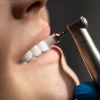
Keeping your teeth free from harmful plaque
If they are honest, most people don’t find flossing a particularly enjoyable experience, but it is something that is essential for good dental health, and when correctly done should only take a few minutes to complete. It’s incredibly important to floss once a day as plaque and food debris can get caught in between the contact areas of your teeth, and it is impossible to reach these areas with your toothbrush. These areas are especially prone to tooth decay, and gum disease can often develop in the sections of gum in between your teeth if they aren’t kept clean. The contact areas in between your teeth account for approximately one third of all your tooth surfaces, something that’s worth remembering if you’re tempted to forgo flossing after brushing.
If you fail to floss, then the plaque on your teeth will harden into calculus or tartar. This is something that can happen within a day or two. Hardened calculus can only be removed by a dentist or hygienist. Once you get into the habit of daily flowing you will probably find it much easier, and it simply won’t feel right to avoid it.
Flossing Techniques
Make sure you break off a reasonable length of floss, of approximately eighteen inches. Wrap the ends of the floss around your middle and index fingers, leaving approximately 2 inches between each hand. Gently slide the floss in between your teeth, right down to and just below the base of the tooth so it reaches just underneath the gum. Wrap the floss in a C shape around the tooth and gently slide it all the way up to the top of the tooth so it removes the maximum amount of plaque and food debris. If necessary repeat this step before winding the floss on to a nice fresh section and moving on to the next tooth.
You need to be sure to floss in between every single tooth, including the backs of your last molars. If you haven’t flossed in a while you might find your gums bleed a little, but it’s important to persevere. The bleeding should significantly improve after two weeks or so. If the bleeding doesn’t improve then contact us for advice as you may have the early signs of gum disease which could require additional treatment.
Picking the Right Dental Floss
Research has shown that all types of dental floss are more effective when used properly, but there are a lot of different flosses on the market. Flossing will seem easier if you choose one you like using. Some are designed especially for sensitive gums, and it’s possible to buy floss that is waxed or unwaxed. You can even buy different widths of dental floss to accommodate teeth that are tightly packed together, so it is worth experimenting to find one you feel comfortable using. Some flossers are pre-threaded so they are easier to manipulate.
Alternatives to Dental Floss
If you can’t get on with floss then there are alternative ways of cleaning in between each tooth. It is possible to buy interdental brushes. These are small brushes that come in a variety of widths, and which slide in between each tooth to clean the contact areas. Some of these are angled to make it easier to reach the teeth right at the back. You can also buy soft rubber picks that work in a similar way. These are very slim and easy to fit in between each tooth.
Another solution is to invest in a water flosser. This is an electrical device that works by squirting pressurized water in between the teeth. It is very effective at removing plaque and food particles, and is ideal for anyone who does not have good manual dexterity or who finds it difficult to use ordinary floss.
Our dental staff are always more than willing to offer advice on how to floss properly, so if you do have difficulty please do ask for help.



